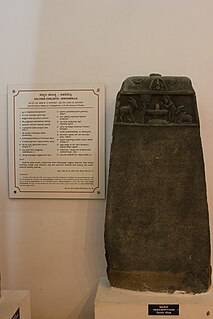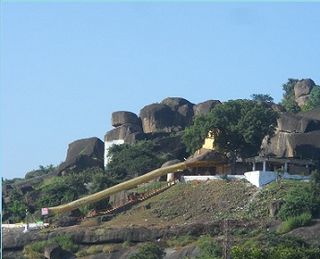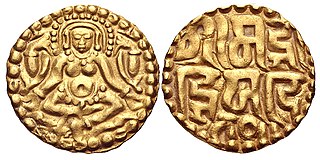Related Research Articles

The Kakatiya dynasty was an Indian dynasty that ruled most of eastern Deccan region comprising present day Telangana and Andhra Pradesh, and parts of eastern Karnataka and southern Odisha between 12th and 14th centuries. Their capital was Orugallu, now known as Warangal.

Eastern Chalukyas, also known as the Chalukyas of Vengi, were a dynasty that ruled parts of South India between the 7th and 12th centuries. They started out as governors of the Chalukyas of Badami in the Deccan region. Subsequently, they became a sovereign power, and ruled the Vengi region of present-day Andhra Pradesh until c. 1130 CE. They continued ruling the region as feudatories of the Cholas until 1189 CE.

Tailapa II, also known as Taila II and by his title Ahavamalla, was the founder of the Western Chalukya dynasty in southern India. Tailapa claimed descent from the earlier Chalukyas of Vatapi, and initially ruled as a Rashtrakuta vassal from the Tardavadi-1000 province in the modern Bijapur district of Karnataka. When the Rashtrakuta power declined following an invasion by the Paramara king Siyaka, Tailapa overthrew the Rashtrakuta king Karka II, and established a new dynasty.

The Chaulukya dynasty, also Solanki dynasty, was a dynasty that ruled parts of what are now Gujarat and Rajasthan in north-western India, between c. 940 CE and c. 1244 CE. Their capital was located at Anahilavada. At times, their rule extended to the Malwa region in present-day Madhya Pradesh. The family is also known as the "Solanki dynasty" in the vernacular literature. They belonged to the Solanki clan of Rajputs.

Padmakshi Temple is one of the oldest temples in the Hanamakonda area of Telangana, India. It is dedicated to the Hindu goddess Padmakshi (Lakshmi), and also features Jain imagery.

The Kalachuris of Tripuri, also known the Kalachuris of Chedi, ruled parts of central India during 7th to 13th centuries. They are also known as the Later Kalachuris to distinguish them from their earlier namesakes, especially the Kalachuris of Mahishmati. Their core territory included the historical Chedi region, and their capital was located at Tripuri.
Jaitugi, also known as Jaitrapala, was a ruler of the Seuna (Yadava) dynasty of Deccan region in India.
The Chalukyas of Vemulavada were an Indian dynasty that ruled in and around the present-day Telangana between 7th and 10th centuries. Their capital was located at Vemulavada, and they were vassals of the Rashtrakutas.
Baddega, who assumed the title Solada-gaṇḍa, was an Indian ruler from the Vemulavada Chalukya dynasty. He was a vassal of the Rashtrakuta king Krishna II, and participated in Krishna's unsuccessful invasions of the Vengi Chalukya kingdom.
Arikesari II was a ruler of the Vemulavada Chalukya dynasty of present-day Telangana, India. A Rashtrakuta vassal, he played an important role in dethroning the Rashtrakuta emperor Govinda IV and enthroning Amoghavarsha III as the new emperor. He was the patron of Pampa, one of the earliest notable Kannada-language poets.
Prola II was a Kakatiya chief who ruled the area around Anumakomda as a vassal of the Kalyani Chalukyas. He was the father of Rudra-deva, the first sovereign ruler of the Kakatiya family.
Gunda III, also known as Gundyana or Gundana, was a member of the Kakatiya dynasty of southern India. He served the Rashtrakuta king Krishna II, and died during Krishna's invasion of the Vengi Chalukya kingdom. He is the earliest known member of the Kakatiya family to have been in the Telugu-speaking region.
Gunda IV alias Pindi-Gunda was a member of the Kakatiya dynasty of southern India. As a Rashtrakuta general, he helped the Vengi Chalukya prince Danarnava ascend the throne after a succession dispute. In 973 CE, after the collapse of the Rashtrakuta empire and the murder of Danarnava, he attempted to carve out an independent principality at Kuravi. The Kalyani Chalukyas, who had usurped the power from the Rashtrakutas, probably defeated and killed him, supported by the Mudugonda Chalukyas, the former rulers of Kuravi.
Beta I, also known as Garudanka Beta or Garuda Beta, was a member of the Kakatiya dynasty of southern India. His father Gunda IV was a Rashtrakuta vassal, and was killed in a conflict with the Kalyani Chalukyas who usurped the power from the Rashtrakutas. Beta accepted the suzerainty of the Kalyani Chalukyas, participated in their war against the Cholas, and obtained Anamkonda as fief.
Prola I was a member of the Kakatiya dynasty of southern India. As a Kalyani Chalukya vassal, he participated in prince Vikramaditya VI's campaigns, and consolidated the Kakatiya control over the area around Anumakonda by subjugating local chiefs. He obtained the Anumakonda vishaya and its neighbouring lands as a hereditary fief from the Chalukya king.
Beta II alias Tribhuvana-malla was a member of the Kakatiya dynasty of southern India. As a Kalyani Chalukya vassal, he obtained control of the Sabbi-1000 province centred around Vemulavada. He commissioned a Shaivite shrine, and also donated land for a Jaina temple.
Durga-raja was a member of the Kakatiya dynasty of southern India. He is attested by only one record - the 1098 CE Kazipet dargah inscription, which was issued during the reign of his father Beta II. According to one theory, he probably ruled for a short period and rebelled against his Kalyani Chalukya overlord, before being subjugated by his brother Prola II who remained loyal to the Chalukyas.
Rudra-deva was a Kakatiya king, who ruled parts of the present-day Telangana and Andhra Pradesh in southern India. He was the first sovereign ruler of his dynasty.
Mahadeva was a ruler of the Kakatiya dynasty which ruled in the present-day Telangana and Andhra Pradesh regions of India. He died in battle during an invasion of the neighbouring Seuna (Yadava) kingdom. The Yadavas captured his son Ganapati, but later reinstated him on the Kakatiya throne.
Ganapati-deva was the longest reigning monarch of the Kakatiya dynasty of southern India. He brought most of the Telugu-speaking region in present-day Andhra Pradesh and Telangana under the Kakatiya influence by war or diplomacy.
References
- 1 2 P.V.P. Sastry 1978, p. 39.
- ↑ R.S. Sharma 1957, p. 197.
- ↑ P.V.P. Sastry 1978, pp. 37–39.
- ↑ P.V.P. Sastry 1978, pp. 18, 39.
- ↑ R.S. Sharma 1957, p. 198.
Bibliography
- P.V.P. Sastry (1978). N. Ramesan (ed.). The Kākatiyas of Warangal. Hyderabad: Government of Andhra Pradesh. OCLC 252341228.
- N. Venkataramanayya; P.V.P. Sastry (1957). "The Kākatīyas". In R.S. Sharma (ed.). A Comprehensive history of India: A.D. 985-1206. Vol. 4 (Part 1) (1987 reprint ed.). Indian History Congress / People's Publishing House. ISBN 978-81-7007-121-1.